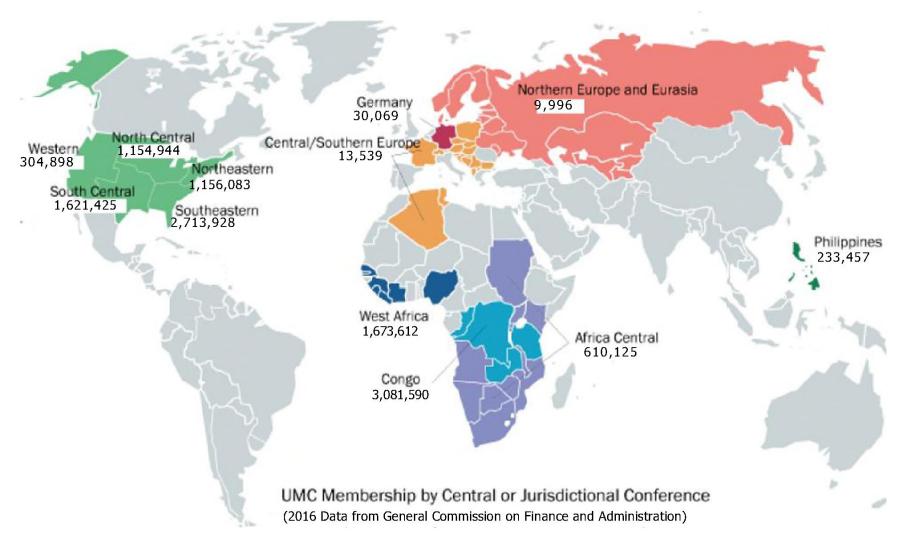Information about the Conferences outside the United States of America, called "Central Conferences."
by David W. Scott
July 23, 2019
Having looked at how much total United Methodists in the United States send annual to the central conferences (probably over $100 million per year), it is worth looking at how much money the central conferences likely generate themselves in giving by members in those central conferences.
While much uncertainty exists, the total given to local churches in the central conference might be between $110-470 million per year, though likely near the lower end of that estimate. Even the most conservative estimates yield at least $60 million in member giving. As in the United States, the majority of this stays in local congregations, with only a small fraction being used to support connectional ministries.
by David W. Scott
July 22, 2019
Last week, I wrote about U. S. subsidies to the central conferences. Yet that post did not indicate the total size of those subsidies. What is that number? In short, it’s likely that over $100 million a year flows from the United States to the central conferences. Here’s how that breaks down into apportionments, given either directly or through the general boards and agencies, and partnerships with annual conferences, individual congregations, and advocacy groups. [Continue reading at UM-Insight.net.]
by Dr. David W. Scott
July 15, 20194
Scott is UM & Global blogmaster and Director of Mission Theology at the General Board of Global Ministries.
One significant feature of the financial realities of The United Methodist Church is that the American (and Western European) branches of the church provide extensive funding, in-kind gifts, technical expertise, and human resources for a variety of ministries in the central conferences. This practice can be read as a just response to global economic inequalities, a commendable practice of charity, or a form of neo-colonial control. Whether such subsidies are good, bad, or indifferent is a case-by-case personal judgment, and this post will not attempt to make such judgments.
Instead, this post will briefly cover the ways in which American (and Western European) churches subsidize ministry elsewhere and why those subsidies are currently at risk. A subsequent post will explore what options central conferences have if/when those subsidies do decrease. [Read more on UM-Insight.]
by David W. Scott
July 17, 2019
Scott is UM & Global blogmaster and Director of Mission Theology at the General Board of Global Ministries.
As a previous post explained, churches, annual conferences, and other groups in the United States provide significant financial, in-kind, technical, and personnel subsidies to churches, annual conferences, and other ministries in the central conferences. However, for a variety of reasons, those subsidies are likely to decrease, perhaps quite significantly, in coming years. The question then arises of what options central conferences have for their ministries in the face of reduced American subsidies.
It is important to state up front that some, perhaps many, of the decisions about subsidized ministries and programs in the central conferences will not be made by people in the central conferences themselves but rather by the Americans who are currently sending the subsidies. For those ministries and programs completely dependent on American or general agency support, it is effectively Americans and/or general agency boards and staff who will make decisions about the fate of ministries in the central conference, not the people from central conferences conducting those ministries.
Despite the ways in which American decision-making will impact those in the central conferences, central conference church leaders also have agency in this process. Thus, there are a variety of decisions they can make or strategies they can adopt in the face of reduced American subsidies. [Read the entire article on UM-Insight.net.]
The 2019 General Conference: Central Conferences 101
 The United Methodist Church is organized into annual conferences on a world-wide basis. In the US, the annual conferences are grouped together into 5 jurisdictions. Outside of the US, the annual conferences are grouped together into 7 central conferences with an 8th in formation in mainland Asia. The map above shows the most recent membership of the UMC by jurisdiction and central conference. Because United Methodism is growing in Africa and the Philippines, the UMC is seeing a shift in its membership to outside the US.
The United Methodist Church is organized into annual conferences on a world-wide basis. In the US, the annual conferences are grouped together into 5 jurisdictions. Outside of the US, the annual conferences are grouped together into 7 central conferences with an 8th in formation in mainland Asia. The map above shows the most recent membership of the UMC by jurisdiction and central conference. Because United Methodism is growing in Africa and the Philippines, the UMC is seeing a shift in its membership to outside the US.
